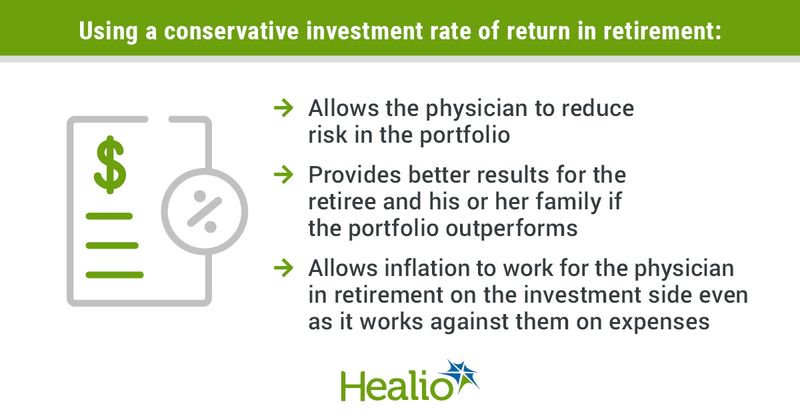Do not outlive your money: What inflation rate to use for your retirement projections
Click Here to Manage Email Alerts
Most investors, when considering their financial future, have a common number one concern – that they will not have saved enough to sustain them in retirement. In other words, they fear that they will outlive their money.
Physicians are not immune to this worry. Thankfully, many physicians are diligent about saving and investing. Some turn to professional advisors to help them model their savings needs throughout their careers to make sure they are “on track.” Whether done with an advisor or modeled on one’s own using a simple spreadsheet, inflation is an important factor that must be considered when projecting future spending. Inflation, like other key assumptions for financial modeling, such as future income, expenses, investment returns and health, is not stagnant and changes over time.

As we all know, inflation has risen significantly over the last year or so. Not only does this impact our present spending and cash flow, but it has led many physicians to rethink their retirement projections, including higher inflation rates for those models. In this article, we will discuss the all-important factor of inflation and consider what inflation rate physicians should use in their retirement modeling.
Inflation today, long-term assumptions

With good reason, inflation has been on the minds of many physicians. In 2022, the annual inflation number was 6.5%. At its peak in June 2022, it was 9.1% and even year-to-date, it has been 4.9%. As you will see, these are much higher rates than we have been accustomed to, and, as such, concerns about inflation have increased.
Since retirement projections will span a few decades for the older physiciant – and 50 years or more for the young physician – looking at the inflation rates over the last year or 18 months is not helpful. We need more data and a longer time period. If we examine inflation over the last 20 years, the average rate has been 2.25%; over 30 years, it has been about 2.5%. If we want to go back over 100 years, we can look at the Consumer Price Index (CPI) all the way back to 1921, where the average has been 3.21%. Typically, the advisors at OJM Group use the 30-year average of 2.5% as the starting point for a retirement projection when speaking with clients.
Right measure for retirement modeling


When most people discuss inflation rates, including our data above, they refer to the CPI. This is the most common measure used in the U.S. to measure inflation. Importantly, housing is almost one-third of the CPI. This heavy weight for housing may make sense for the general population, as many people have a large rent or mortgage expense in their monthly budget.
However, for most physicians in retirement, this will not be the case. In fact, in the experience that the OJM Group has had in its work with well over 1,000 physicians, most will have either a fixed rate mortgage for housing costs or no mortgage at all by the time they retire. As such, using the full CPI rate for retirement projections may be higher than realistic. Generally, for retirement projection purposes, it may make sense to reduce the 30-year average by 12% to 20%, depending on the physician’s likely housing situation.
Investment return assumption
When building out retirement models, physicians should consider erring on the side of conservatism when selecting an investment return assumption, especially during retirement years. Thinking one is “on track” using high return assumptions often means taking on more risk in one’s portfolio. This can be especially problematic in retirement because of the sequence of returns risk, which is the danger that the timing of liquidation and withdrawal from a retirement account will coincide with a downturn in the market.
It may be wiser to use a conservative investment rate of return in retirement. For one, this allows the physician to reduce risk in the portfolio. If financial goals can be met without taking on excessive risk, why not do that? Further, if a portfolio designed to earn a lower (conservative) rate of return outperforms, the results are even better for the retiree and his or her family.
Third, by using a conservative rate of return, inflation can work for the physician in retirement on the investment side even as it works against them on expenses. In essence, in times of higher inflation, the most conservative investments may have an opportunity to provide a decent return, which could be enough to sustain a portfolio that only needs to meet conservative assumptions.
Consider today as an example. Let’s assume Dr. Owen had built a retirement projection where he only needs to get a 5% return now that he is retired. With inflation elevated over the last year, he might be able to get a large portion of the return he needs simply from a money market account. He could allocate just a small fraction of the investments to higher risk assets to make the 5% that he needs. In this way, Owen benefits from today’s higher inflation on the investment side of the spending-earning balance.
Spread between inflation, investment rate
In the example of Owen above, we see that inflation can be a “double-edged sword.” While it can eat away at purchasing power and thus require more dollars in retirement to sustain a lifestyle, it is also associated with higher interest rates which can make returns on cash and cash equivalents (like money market funds) rise. In this way, what is more important for retirement projections than the nominal inflation rate is the spread between investment returns and the inflation rate.
If inflation is higher than average, cash is going to earn higher than normal returns and bond yields are also going to be higher. As an example, if inflation is running at 3.5% long term (one-third higher than its 30-year average), there is a reasonable expectation bonds will be yielding over 5% and a 60 equity-40 bond portfolio could earn closer to a historical average of around 7%. In other words, if inflation is higher than its historical average, we would expect that conservative asset classes will have higher than average returns as well, so dynamic retirement portfolios could move in step with inflation and not harm the client’s retirement.
Of course, this may not always be the case and gets back to why building conservative retirement projections on both the expense side (including the inflation factor) and investment return side is crucial, as is adjusting them each year as one works and as one lives off the assets in retirement.
Conclusion
There are many dynamic factors that impact long-term financial goals, including retirement. A professional advisor can be extremely helpful in crafting a realistic retirement model with built-in flexibility to adapt to changes in inflation rates, tax rates, expenses and investment returns.
References:
Current US inflation rates: 2000-2023. https://www.usinflationcalculator.com/inflation/current-inflation-rates/. Accessed July 5, 2023.
United States – 20-year breakeven inflation rate.
United States – 30-year breakeven inflation rate. https://tradingeconomics.com/united-states/30-year-breakeven-inflation-rate-fed-data.html#:~:text=United%20States%20%2D%2030%2Dyear%20Breakeven%20Inflation%20Rate%20was%202.26%25,1.29%20in%22March%20of%202020. Accessed July 5, 2023.
US consumer price index YoY. https://ycharts.com/indicators/us_consumer_price_index_yoy. Accessed July 5, 2023.
Wealth Planning for the Modern Physician and Wealth Management Made Simple are available free in print or by ebook download by texting HEALIO to 844-418-1212 or at www.ojmbookstore.com. Enter code HEALIO at checkout.
For more information:
Sanjeev Bhatia, MD, is an orthopedic sports medicine surgeon practicing at Northwestern Medicine in Warrenville, IL. He can be reached at sanjeevbhatia1@gmail.com or @DrBhatiaOrtho.
David B. Mandell, JD, MBA, is an attorney and founder of the wealth management firm OJM Group www.ojmgroup.com, where Michael Lewellen, CFP, is a partner and director of financial planning. They can be reached at 877-656-4362 or mandell@ojmgroup.com.

